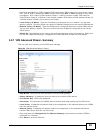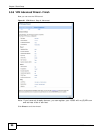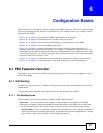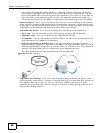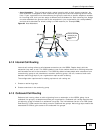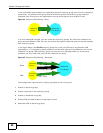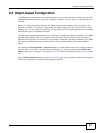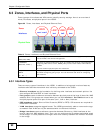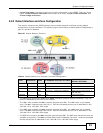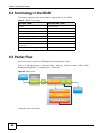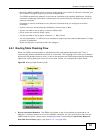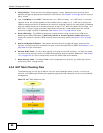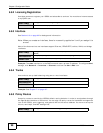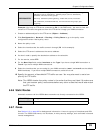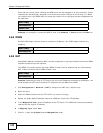
Chapter 6 Configuration Basics
ISG50 User’s Guide
93
• Virtual interfaces increase the amount of routing information in the ISG50. There are three
types: virtual Ethernet interfaces (also known as IP alias), virtual VLAN interfaces, and
virtual bridge interfaces.
6.3.2 Default Interface and Zone Configuration
This section introduces the ISG50’s default zone member physical interfaces and the default
configuration of those interfaces. The following figure uses letters to denote public IP addresses or
part of a private IP address.
Figure 67 Default Network Topology
Table 14 ISG50 Default Port, Interface, and Zone Configuration
• The WAN zone contains the wan1 and wan2 interfaces (physical ports P1 and P2). They use
public IP addresses to connect to the Internet.
• The LAN1 zone contains the lan1 interface (physical port P3). The LAN1 zone is a protected
zone. The lan1 interface uses 192.168.1.1 and the connected devices use IP addresses in the
192.168.1.2 to 192.168.1.254 range.
• The LAN2 zone contains the lan2 interface (physical port P4). The LAN2 zone is a protected
zone. The lan2 interface uses 192.168.2.1 and the connected devices use IP addresses in the
192.168.2.2 to 192.168.2.254 range.
• The DMZ zone contains the dmz interface (physical port P5). The DMZ zone has servers that are
available to the public. The dmz interface uses private IP address 192.168.3.1 and the connected
devices use private IP addresses in the 192.168.3.2 to 192.168.3.254 range.
PORT INTERFACE ZONE IP ADDRESS AND DHCP SETTINGS
SUGGESTED USE WITH
DEFAULT SETTINGS
P1, P2 wan1, wan2 WAN DHCP clients Connections to the Internet
P3 lan1 LAN1 192.168.1.1, DHCP server enabled Protected LAN
P4 lan2 LAN2 192.168.2.1, DHCP server enabled Protected LAN
P5 dmz DMZ 192.168.3.1, DHCP server disabled Public servers (such as web, e-
mail and FTP)
CONSOLE n/a None None Local management



